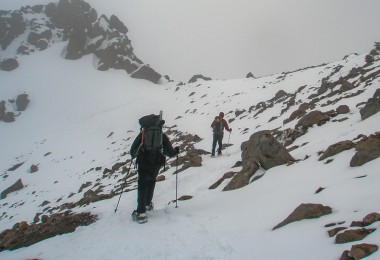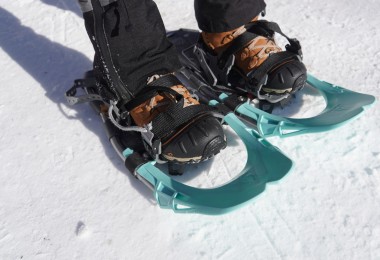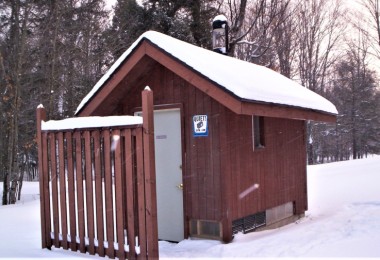When I moved to the Northeast after a lifetime spent in the South, I was introduced to a new piece of outdoor clothing. I quickly discovered that gaiters were more than an accessory for winter outdoor recreation unless I wanted to end my snowshoeing wearing wet socks and dragging sodden pant cuffs! Since then, I have regarded myself as a true connoisseur of this particular piece of gear.
Years ago, there weren’t so many choices in gaiters as there was one single choice: cotton duck or felted wool. But things have changed, so much so that the options can be a little bewildering. So what do you do if you are looking to invest in your very first pair of gaiters for snowshoeing or to move up a class?
There’s no reason to purchase the lowest-priced selection and cross your fingers that they won’t fall apart within the season. Or, on the flip side, buy the most expensive model on the market in the hope that price equals quality.
Instead, consult this guide and pick up in a few minutes of reading what I picked up over a few years of firsthand experience and study.

These gaiters were worn by the members of the 10th Mountain Division during World War II. Photo: Matthew Timothy Bradley
Some of the links in this article may contain affiliate links. When you purchase using these links, part of the proceeds go to Snowshoe Mag. Additionally, as an Amazon Associate, we earn from qualifying purchases. Please see our disclosure for more details.
Gaiter Features
When choosing your gaiter for snowshoeing, there are four design features to consider: height, water repellency, durability, and the closure system.
Height
Gaiters come in three heights: ankle, mid-calf, and full length (which extends to the knee).
1. Ankle gaiters are a good choice if running and racing are your snowshoe activity of choice. For example, the INSTAgaiter is a low gaiter from Kahtoola.
2. Mid-calf gaiters may suffice if you plan on sticking to broken trails. Otherwise, snow will most likely find its way over the tops of your gaiters if you break your own trail. This process will happen quickly if your route involves wind-blown terrain marked by drifts or climbing. Also, mid-calf gaiters can be prone to sagging unless genuine care has been taken in their design and construction. However, REI makes a durable Backpacker Low Gaiter to keep out the elements that could be worth a try.
3. Full-length gaiters are highly recommended if there is the slightest chance you will spend time breaking trails or in wet snow. Anything less than full to-the-knee coverage in wet snow will result in a good soaking for the lower portion of your trousers. A simple but valuable full-length gaiter is the Rocky Mountain High by Outdoor Research (available in men’s and women’s sizes).
Read More: What To Bring When Snowshoeing: Top Accessories for the Day Hiker
Water Repellency
Some models of gaiters incorporate a waterproof-breathable layer such as GORE-TEX or eVent. This layer is not meant to create an impenetrable top-to-bottom seal since the bottom edge of the gaiter is not completely tight. Instead, it is intended to keep moisture from soaking the wearer’s trouser bottoms.
An example of a full-length gaiter with GORE-TEX is the Crocodile GORE-TEX Gaiter by Outdoor Research (available in both men’s and women’s sizes).
But is waterproof-breathable construction a must-have?
If you snowshoe where wet snow conditions are the rule rather than the exception (e.g., the Pacific Northwest), you have every reason to invest in the feature. In addition, since GORE-TEX and eVent serve to deflect wind and water, snowshoers who often find themselves on the prairie or above treeline will also get a good return on investment.
Otherwise, gaiters that are water-repellent are usually up to the task. These could include a pair of Durable Water Repellent (DWR) treated nylons gaiters. For almost four seasons now, I have been using a pair of surplus Swiss Army waxed wool gaiters (similar to these). I wouldn’t trade these for the fanciest set of space-age leggings.
Read More: Snowshoeing Footwear: Tips for Choosing Your Boot
Durability
The instep of some gaiters includes a patch of durable material known as a kick panel. In addition, the design can incorporate a lower section of rugged fabric, such as 1,000 denier Cordura nylon.
The Hillsound Armadillo LT is one example of a gaiter with a rugged fabric for increased durability.
However, a kick panel or rugged fabric is a must-have for those who might put their gaiters to use with independent crampons (like Kahtoola Microspikes or Yaktrax Summit). And all other things being equal, a gaiter featuring one or the other will enjoy a longer lifespan since the additional fabric helps provide abrasion resistance needed at a high-wear area of the gaiter.
Read More: Yaktrax Reviews: The Ascent and Summit for Slippery Climbs

The right kick panel on my surplus Swiss Army gaiters is visible in this photo. Photo: Matthew Timothy Bradley
Closure System
Some closure systems fix via hook-and-loop, a bottom and top snap, and others via a zipper. Each has its strengths and weaknesses.
For example, velcro closures can become fouled by snow, and opening a hook-and-loop closure in the field invites trouble. This fact is particularly true when the snow is powdery and being kicked around by the wind. Likewise, zippers come with their own problems as they are more challenging to open and close with gloved or cold hands than velcro. Zippers can also split or become stuck.
So, one possible solution is to use a model featuring multiple types of closures. Ultralight backpackers may take a dim view of that. However, it is always worth considering what weight you can afford to carry and what weight you can’t afford not to carry. Five miles into a ten-mile trudge through heavy, wet snow is not a good time for the distinction to cross one’s mind for the first time.
If you go with a zippered closure, top-to-bottom closing and bottom-to-top opening are a nice touch. It may sound trivial, but it takes some fuss out of getting into your gaiters and getting you and your raquettes on your way.
Read More: Kahtoola NAVAgaiter Review: A Gaiter for Any Terrain
Get Your Gaiters for Snowshoeing
So, before embarking on your next snowshoe adventure, consider these four features to determine the gaiter that is best for you and the conditions in which you’ll be snowshoeing.
What about you? Do you use gaiters for snowshoeing? What are some of your favorite types and recommendations? Please share your thoughts in the comments below.
This article was originally published on March 18, 2014. It was updated to include additional product examples and links on December 22, 2022.
Read Next: Snowshoeing Dress Code: Tips for What Clothing to Wear







Kahtoola makes the best gaiters hands down!
When it comes to choosing gaiters, durability is key, especially if you want your gear to stand up to season after season of abuse.
CORDURA(R) Brand
Account Manager
I agree, Tina. In my own experience, CORDURA is a great choice, as is SuperFabric. No other textile I have seen so far even comes close.